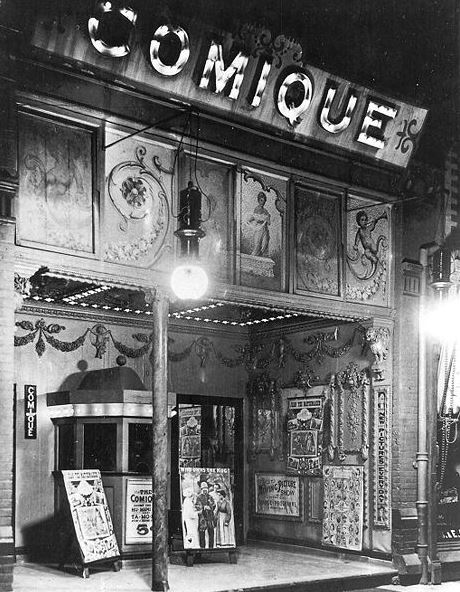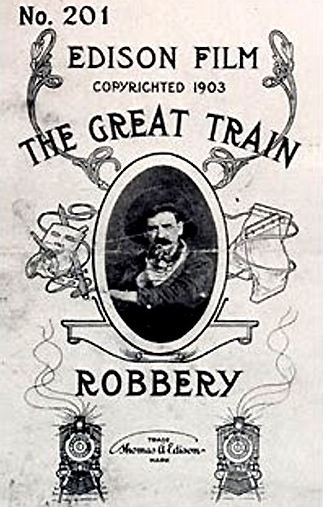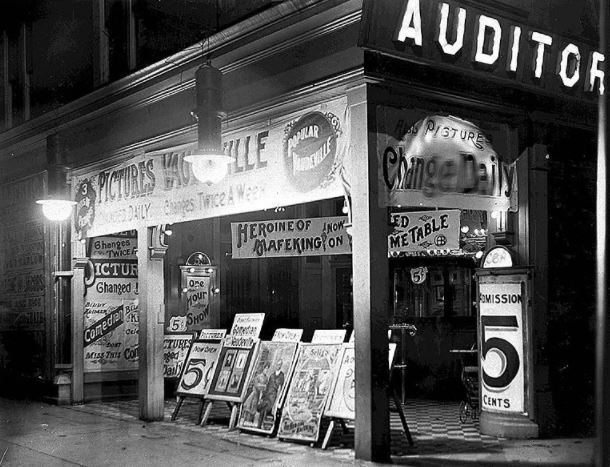While streaming services are now becoming an option nowadays, they cannot match the feeling that movie theaters foster. From spending time with your entire family or a big group of friends to the preshow fun, unmatched sound and visual presentations, movie-going culture, and even the popcorn, movie theaters simply provide the ultimate experience.
But have you ever wondered where and where it all started? With nearly 200,000 cinema screens worldwide, what was actually the first movie theater? Well, keep rolling as in this article we’ll discover more about Nickelodeon, the first-ever motion picture theater in the world.
The First Nickelodeon Opens
On the 19th of June 1905, nearly 500 people gathered in Pittsburgh, Pennsylvania for the opening of the world’s first theater exclusively built for showing motion pictures – the nickelodeon. It was established by Harry Davis, a vaudeville impresario who envisioned creating a theater solely intended for the shadows.
David purchased a cinematograph or an early motion-picture projector from a Frenchman known as Lumiere. He set up the small, simple theater in a converted storefront situated on Smithfield Street’s west side in downtown Pittsburgh. It housed almost a hundred seats with a piano, all fronting the framed screen. Each moviegoer was charged five cents for admission.
The name nickelodeon was derived from the name of the U.S. five-cent coin, nickel, and from the Greek term for theater, “odeion.” Though the nickelodeon wasn’t the first theater to screen films, it was the first one dedicated to showcasing moving picture spectacles.
The Proliferation
The operation of the first nickelodeon found massive success and the five-cent theater concept soon proliferated after many other businessmen imitated them, as well as the name itself. From 1907 to 1908, it was estimated that there were about 8,000 nickelodeons in the country, and by 1910, there were about 10,000 with millions of Americans watching in these theaters per week.
Larger nickelodeons soon arrived, with other converted storefronts offering seats up to less than 200 people. Moviegoers sat on hard wooden seats, while the screen was suspended on the back wall. Even larger nickeledeons had a capacity for more than 1,000 people. The piano (and perhaps a drum set) was situated beside or below the framed screen.
In 1907, Louis B. Mayer, Canadian-American film producer and co-founder of MGM studios, renovated and converted the Gem Theater in Massachusetts into a nickelodeon, renaming it as Orpheum Theater. Other notable personalities who owned nickelodeons include William Fox and the Skouras Brothers.
The Features
Nickelodeons’ continual screenings of one- and two-reel films, lasting from 10 minutes to 15 minutes to an hour, all with a piano accompaniment. One of the first films in Davis’ nickelodeon was “The Great Train Robbery.”
It was a 10-minute thriller made by Edwin S. Porter, revolving on a train holdup by a gang of outlaws who were then eventually defeated by a group of locals. Its final scene was iconic, with actor George Barnes, playing the bandit, pointing and shooting his pistol point-blank directly into the camera. Thus, leaving the audience was surely startled and terrified.
To compete with the vaudeville house, nickelodeons also showed films in other varieties of subjects and styles, ranging from actualities (early documentary films), scenics, short narratives, sporting events, comedies, problem plays, stop action flicks, illustrated songs, and other features.
Some of the titles shown in nickelodeons include: “Catch the Kid” (comedy), “The Fatal Hand” (drama), “Roof to Cellar” (comedy), “The Romany’s Revenge,” (drama), “Sailor’s Return” (drama), “Wizard’s World” (comedy), and “Johnny’s Run” (comedy), “Knight-Errant” (old historical drama).
The Change
Indeed, nickelodeons were a massive hit, being able to change the leisure time-habits of a huge chunk of the American people. Practices in film distribution and types of films made were also dramatically transformed. Businesses called “film exchanges” were established. They would purchase films from the producers or manufacturers, which they would later rent out to the theaters. As such, exhibitors had the luxury to screen different films, making the audience return with always something “new” to look forward to.
Later on, longer films also became more preferred. It stirred up fierce competition between film production outfits to create better, more intricate and longer films that would stand out from the others. Longer films were also considered these times’ money-making flicks, as exhibitors from theaters also desired these types of films.
Such pressure forced directors to bring out their more artistic innovations to engage and please the audiences. Actualities, which were usually short, were also soon replaced by longer, easier-to-make fictional films that soon became the standard. All these developments enabled nickelodeons to proliferate in the country.
The Fall
From 1905 to 1913, nickelodeons were incredibly successful. What’s ironic is that what made them grow rapidly is what also caused their demise. With the advent of longer and better films, attendance also increased swiftly, bringing the need for even larger moviehouses and auditoriums.
As feature films also arrived, cities had built more comfy, modern movie theaters for the public, rendering the unrefined, ill-ventilated nickelodeon’s outdated. By the 1920s, the trend was already building furnished and lavish movie theaters, characterized by gaudy exteriors and rousing displays in Middle Eastern, Asian, or art deco style and architectures.
Final Words
Though the life of the nickelodeons was cut short, there’s no doubt about the massive contribution and influence it brought to the film industry. Prior to their arrival, only middle-class people were able to afford to watch vaudeville for a whole quarter. With the nickelodeons, the common people had the chance to see entertainment by only costing a nickel.
Of course, their rapid growth in the number of nickelodeons also sparked the need for more films. Soon, they also require longer and better quality, which elevated the creative prowess of filmmakers and the overall standard of cinema. Their eventual fall also led to even something great. As renowned film historian Charles Musser put it, it’s from the nickelodeons where modern cinema began.



